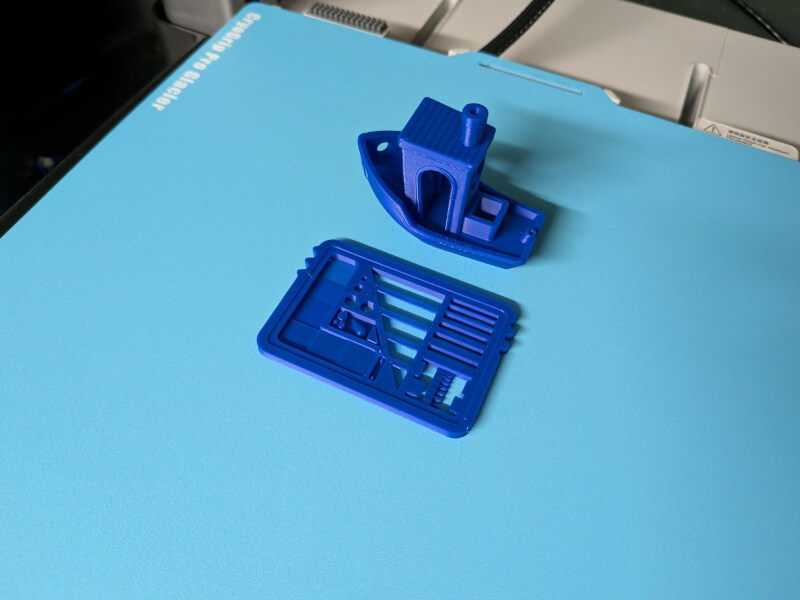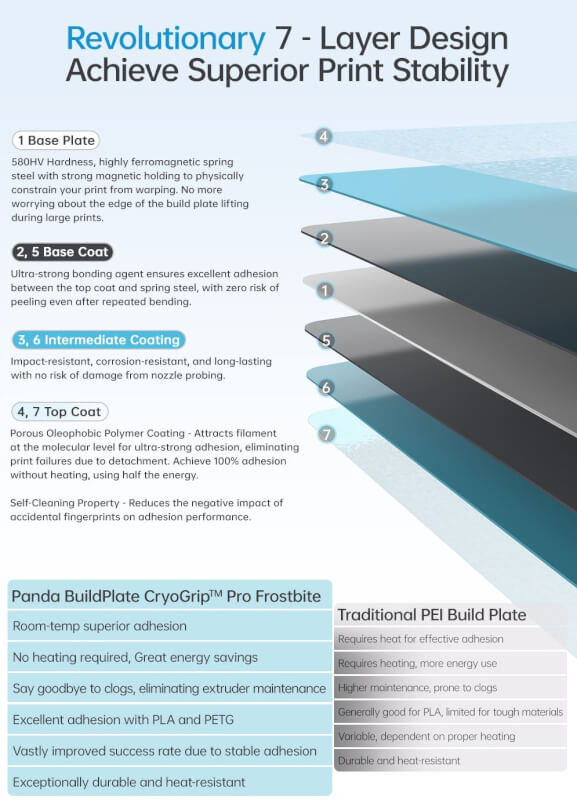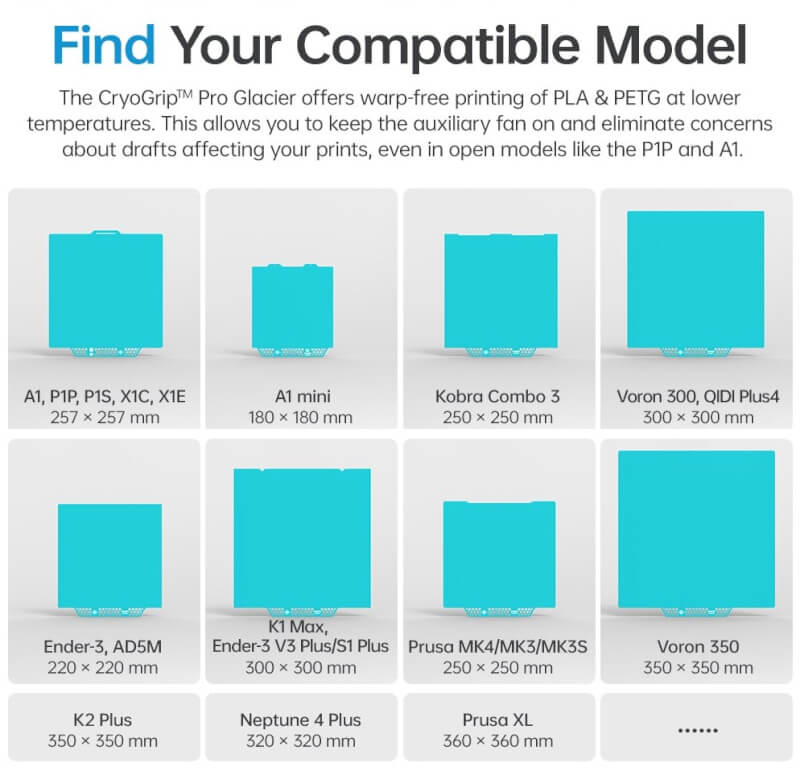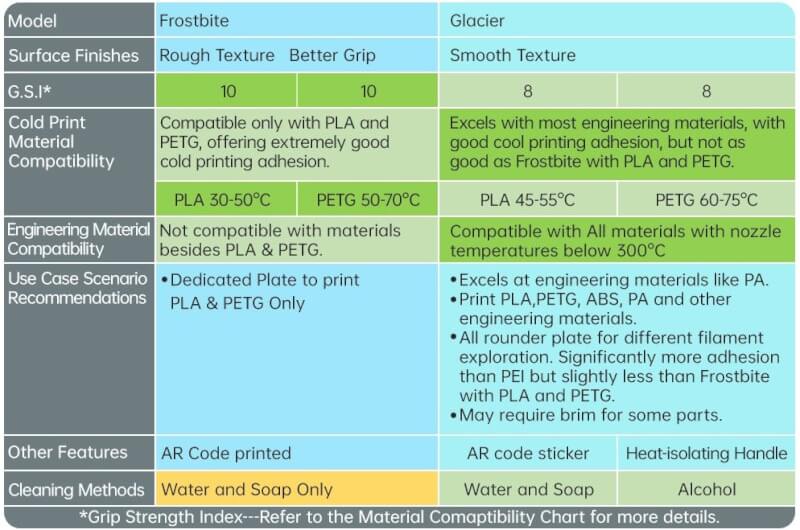BIQU Panda BuildPlate CryoGrip

Central Specifications
- Printing at lower temperatures
- Energy-saving
- Double-Sided 7-Layer Composite

A tour around BIQU Panda BuildPlate CryoGrip
The kit we are looking at today contains two plates. Both are flex plates in the same style as those already used on Bambu Lab printers.
Both plates are blue, so they stand out clearly and fit in nicely with the cold theme. The set consists of a Frostbite plate with a textured surface and a Glacier plate with a smooth surface.
Both plates we tested are compatible with the Bambu Lab A1, P1P, P1S, X1C and X1E. However, the plates are also made for a variety of other printers.

If we look at the specifications of the Frostbite plate, it is made for PLA and PETG and allows for plate temperatures for PLA of 30-50 degrees and 50-70 degrees for PETG.

The Glacier plate offers more options as it can be used with all materials that print at less than 300 degrees. Glacier allows for PLA printing at 45-55 degrees and PETG at 60-75 degrees.
Both plates can be equipped with QR codes so that they can be used with the advanced features of the X1C printers from Bambu Lab.
Both boards feel of good quality and can easily be compared to the quality of Bambu Lab's own build plates.
Test
There are naturally no major drawbacks to using the BIQU Panda BuildPlate CryoGrip plates. Since they are magnetically attached in the same way as the standard plates. I have tested them with both a Bambu Lab A1 and a P1S.
Just like with the Bambu Lab plates, you just magnetically place them on the printer and you're ready to print.
From here, it is in the settings that you need to adjust things. If you have a Bambu Lab X1 Carbon printer, the printer can automatically detect which plate is on it. A set of QR codes is included that can be stuck on the plate, so that it best suits the material you print with most.
In my case with an A1 and a P1S printer, however, I had to manually indicate that there was an alternative plate on it, and specify a new lower temperature on the plate.
From here, there is nothing to do but sit back and await the results.
During my testing, I didn't quite manage to hit the lowest stated temperature level.
I got the temperature down to 40 degrees with the Frostbite plate with PLA. On the Glacier plate I managed to get the temperature down to 50 degrees also with PLA.
There are several advantages to printing at a lower plate temperature. The most obvious is of course the energy savings that come from not having to heat the plate up quite as much.
A lower temperature can also make it easier to print in e.g. PLA without the printed parts warping due to the heat. PLA in particular can be vulnerable in this regard, especially when printing large parts.
During my testing, I had no problems using the plates with the lower temperatures, after I had tuned in to what worked with the PLA filament I was testing with.
After that, I found that my prints stuck just as well as on Bambu Lab's own places with the normal temperature recommendations.
Price
At the time of writing, I can find the BIQU Panda BuildPlate CryoGrip plates with online prices of around 35$ per plate. So around 20$ cheaper than an official Bambu Lab build PEI build plate.
Conclusion
My time with the BIQU Panda BuildPlate CryoGrip plates has been a good experience. In terms of quality, I can't see much difference between them and the official Bambu Lab plates.
On top of that, the plates made it possible to print at a lower plate temperature without any decrease in functionality or quality.
When it can be done at a price that is cheaper than the official records, it's hard to find much to complain about.
We land with a final grade of 9 for a good alternative to the official build plates from Bambu Lab and even with more functionality.
Benefits
- Prints well at lower temperatures
- Sharp price
Disadvantages
- Nothing noteworthy

Latest printer
-
25 Junprinter
-
20 Junprinter
Bambu Lab Store turns three years old
-
25 Marprinter
Bambu Lab launches H2D
-
03 Marprinter
The world's first flying 3D printer
-
14 Febprinter
BIQU Panda BuildPlate CryoGrip
-
22 Janprinter
Elegoo Saturn 4 Ultra 16K
-
20 Janprinter
Bambu Lab security update
-
19 Novprinter
Prusa presents the Prusa CORE One
Most read printer
Latest printer
-
25 Junprinter
Elegoo launches reinforced filament
-
20 Junprinter
Bambu Lab Store turns three years old
-
25 Marprinter
Bambu Lab launches H2D
-
03 Marprinter
The world's first flying 3D printer
-
14 Febprinter
BIQU Panda BuildPlate CryoGrip
-
22 Janprinter
Elegoo Saturn 4 Ultra 16K
-
20 Janprinter
Bambu Lab security update
-
19 Novprinter
Prusa presents the Prusa CORE One






